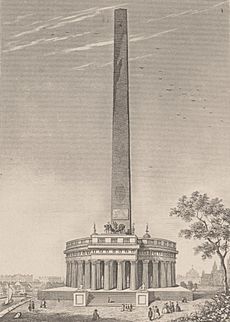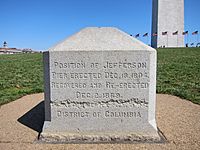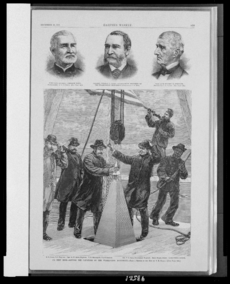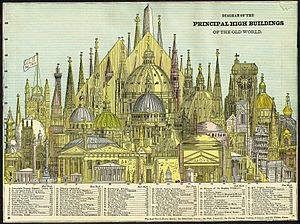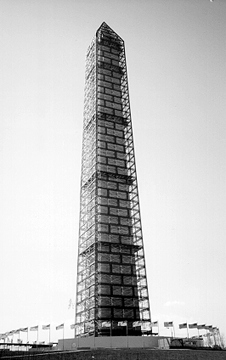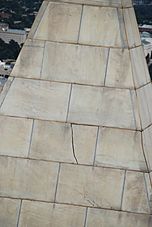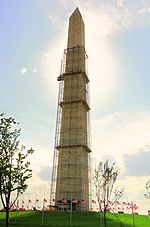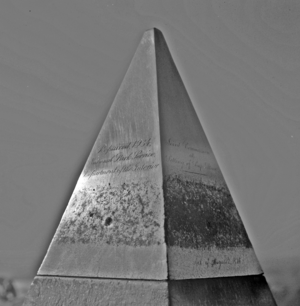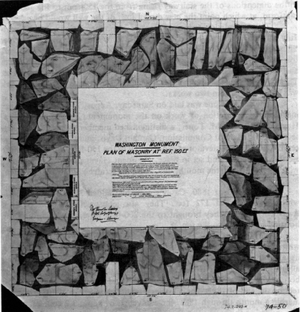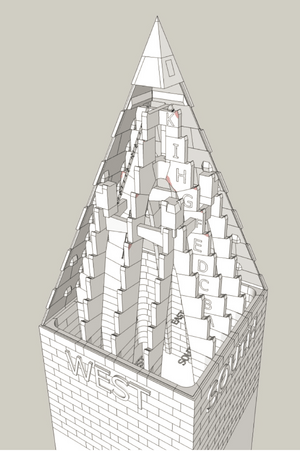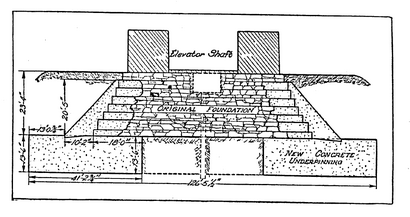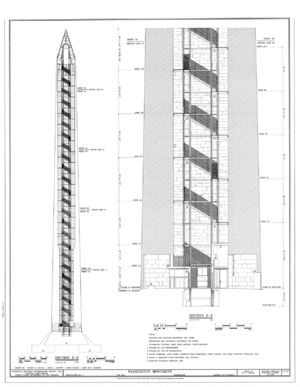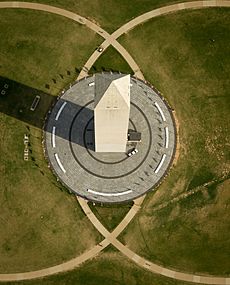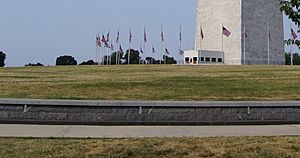Washington Monument facts for kids
Quick facts for kids Washington Monument |
|
|---|---|
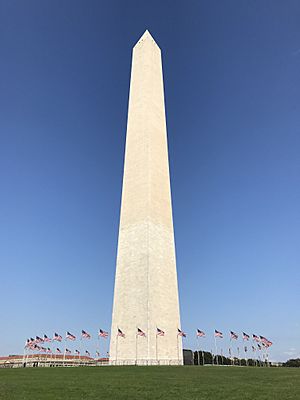
The Washington Monument, pictured in October 2020.
|
|
| Location | National Mall, Washington D.C., United States |
| Area | 106.01 acres (42.90 ha) |
| Height | 555 ft (169 m) |
| Built | 1848–1854, 1879–1884 |
| Visitors | 671,031 (in 2008) |
| Governing body | National Park Service |
| Website | Washington Monument |
| Designated | October 15, 1966 |
| Reference no. | 66000035 |
| Lua error in Module:Location_map at line 420: attempt to index field 'wikibase' (a nil value). | |
The Washington Monument is a tall, pointed stone pillar called an obelisk. It stands proudly on the National Mall in Washington, D.C.. This monument was built to honor George Washington, who was the leader of the Continental Army during the American Revolutionary War. He also became the very first President of the United States.
The monument is made from marble, granite, and a type of stone called bluestone gneiss. It is one of the tallest stone structures and obelisks in the world. It stands about 555 ft (169 m) tall. For a short time, from 1884 to 1889, it was the tallest structure in the world. Then, the Eiffel Tower in Paris became taller.
Building this important memorial started in 1848. However, work stopped for 23 years, from 1854 to 1877. This happened because there wasn't enough money, and there were disagreements about who should manage the project. The American Civil War also caused delays. Even though the stone part was finished in 1884, the inside work and other details weren't completed until 1888. You can see a difference in the color of the marble about 150 feet (46 m) up. This shows where construction paused and then restarted with stone from a different place.
The original plan for the monument was created by Robert Mills. His design included a large circular building at the base, but this part was never built due to a lack of funds. So, only the tall, simple obelisk was constructed. The first stone, called the cornerstone, was placed on July 4, 1848. The monument was officially opened to the public on October 9, 1888.
The Washington Monument is a hollow stone obelisk shaped like an Egyptian pillar. It has a tall column part that is 500-foot (152.4 m) high, topped with a 55-foot (16.8 m) tall pyramid-shaped top called a pyramidion. The walls are very thick at the bottom, about 15 feet (4.6 m), and become thinner at the top, about 1+1⁄2 feet (0.46 m) thick. The lower part of the walls, built first, are made of rough bluestone gneiss and marble. The upper part, built later, uses finished marble and granite stones.
Inside, there are iron stairs that spiral up the walls and an elevator in the middle. The stairs have many landings where you can see special memorial stones. These stones were donated by states, cities, and other groups. The pyramidion at the top has eight windows where visitors can look out. Two aluminum lightning rods protect the monument from lightning strikes. The monument's base is very thick, about 37 feet (11.3 m). The original cornerstone, containing a zinc box with old items, is located 21 feet (6.4 m) underground at the northeast corner. Today, fifty American flags fly around the monument, one for each state.
In 2011, an earthquake caused some damage to the monument, and it was closed for repairs until 2014. It closed again from 2016 to 2019 for elevator repairs and other upgrades.
History of the Monument
Why Was It Built?
George Washington was a very important leader in American history. People called him the "father of his country." He led the American army to victory in the Revolutionary War and became the first president. When he passed away in 1799, many people wanted to build a special memorial to honor him.
At first, there were disagreements in the United States Congress about what kind of memorial to build. Some politicians didn't want to celebrate him because he was linked to a different political party. Also, the idea of building big monuments to powerful people wasn't popular with everyone. These disagreements, along with tensions that led to the Civil War, delayed the monument's construction for many years. Eventually, Washington became a hero that everyone, from both the North and South, could celebrate.
Early Ideas for a Memorial
As early as 1783, even before the capital city was built, the Confederation Congress suggested building a statue of George Washington on horseback. They wanted it in the future national capital. Today, there are two statues of Washington on horseback in Washington, D.C.
After Washington's death in 1799, a committee in Congress suggested building a tomb for him inside the United States Capitol building. However, this idea didn't happen because there wasn't enough money, and Washington's family didn't want his body moved from his home at Mount Vernon.
Designing the Monument
Real progress on a memorial began in 1833. A group of citizens formed the Washington National Monument Society. By 1836, they had collected $28,000 in donations. They then held a competition to find the best design for the monument.
The society wanted the monument to be "unparalleled in the world." They wanted it to be huge and beautiful, something Americans would be proud of. They also wanted it to be made from American marble and granite, with each state contributing materials.
In 1845, the design by architect Robert Mills was chosen. Mills had already designed a monument to Washington in Baltimore. His original plan for the D.C. monument was very grand. It included a circular building 250 feet (76 m) wide and 100 feet (30 m) high, with a 500 feet (150 m) tall obelisk rising from its center. Inside the circular building, there would have been statues of Revolutionary War heroes and signers of the United States Declaration of Independence.
However, this grand design was too expensive, costing over $1 million. So, in 1848, the society decided to build only the simple, plain obelisk. Mills's simplified obelisk was planned to be 500 feet (150 m) tall. It had two large doorways at its base.
Building the Monument
The monument was supposed to be built at a specific spot where lines from the White House and the United States Capitol crossed. This spot was chosen by Pierre L'Enfant in his 1791 plan for the city. But the ground there was too soft for such a heavy structure. So, the monument's location was moved about 390 feet (118.9 m) to the east. At the original spot, there is now a small stone marker called the Jefferson Pier.
Starting Construction
Construction officially began in 1848. The site was dug out, and the cornerstone was laid. The original foundation was built around and on top of this cornerstone. The massive walls started going up the next year.
Historians believe that African-American slaves likely worked on the monument, especially during the first phase of construction (1848–1854). Slavery was common in Washington D.C. and nearby states at that time. Slaves were often used for public and private building projects. While skilled stonemasons were needed for some parts, much of the early work involved unskilled labor.
On July 4, 1848, the Freemasons, a group George Washington belonged to, held a special ceremony to lay the cornerstone. Important people like President James K. Polk and Dolley Madison attended.
Two years later, on July 4, 1850, George Washington Parke Custis, George Washington's adopted son, dedicated a stone from the people of Washington, D.C. President Zachary Taylor was there, just five days before he passed away.
Money Runs Out
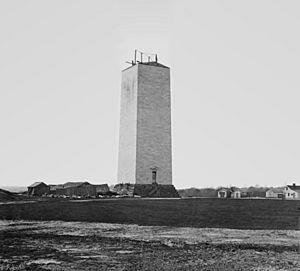
Building continued until 1854, when the monument reached 152 feet (46.3 m) high. Then, donations ran out. A stone donated by Pope Pius IX, called the Pope's Stone, was destroyed by a group called the "Know-Nothings" in 1854. This group was against Catholics and immigrants.
Because of the lack of funds and political problems, construction stopped. The Know-Nothing Party took control of the Washington National Monument Society for a few years. During their time, they only added about four feet to the monument using leftover stones. The original society eventually regained control in 1858. To prevent future takeovers, the U.S. Congress officially made the Society a legal organization in 1859.
After the Civil War
The American Civil War (1861–1865) completely stopped work on the monument. After the war, people became interested in finishing it again. Engineers checked the foundation to make sure it was strong enough. In 1876, Congress agreed to provide more money, $200,000, to restart construction.
There were still debates about the design. Some people thought a simple obelisk without the circular base would look too plain. They even compared it to "a stalk of asparagus"! But eventually, everyone agreed to stick with the simple obelisk and make sure it followed classic Egyptian design rules.
Work Resumes
Construction started again in 1879. Lieutenant Colonel Thomas Lincoln Casey of the United States Army Corps of Engineers led the project. He made the foundation stronger to support the monument's huge weight, which is over 40,000 tons.
The first stone on top of the unfinished part was laid on August 7, 1880. President Rutherford B. Hayes attended this small ceremony. Casey found 92 memorial stones already placed inside the walls from the first phase. He added these and other new stones to the interior walls as construction continued. The bottom third of the monument looks a bit lighter because the marble came from different quarries.
Building moved quickly once there was enough money. In just four years, the monument was completed. The 100-ounce (2.83 kg) aluminum top, which also acts as a lightning rod, was put in place on December 6, 1884. At that time, it was the largest single piece of aluminum ever cast. Aluminum was as valuable as silver back then! The monument officially opened to the public on October 9, 1888.
Dedication Ceremony
The Washington Monument was dedicated on February 21, 1885. More than 800 people gathered on a very cold day to hear speeches. Speakers included Ohio Senator John Sherman and President Chester A. Arthur.
President Arthur declared, "I do now .... in behalf of the people, receive this monument .... and declare it dedicated from this time forth to the immortal name and memory of George Washington."
After the speeches, Lieutenant-General Philip Sheridan led a parade past the White House and to the United States Capitol. Inside the Capitol, more speeches were given. The day ended with a big fireworks display.
Later Years
When it was finished, the Washington Monument was the tallest building in the world. It held this record until the Eiffel Tower was completed in Paris in 1889. It is still the tallest building in Washington, D.C. today.
Many people visited the monument even before it officially opened. After an elevator was installed, the number of visitors grew quickly. By 1888, about 55,000 people visited each month. Between 1979 and 1997, it averaged 1.1 million visitors per year.
In the early 1900s, some material started to seep out from between the stones in the lower part of the monument. People called it "geological tuberculosis." This was caused by the weather affecting the mortar and rubble inside the walls.
In December 1982, a man named Norman Mayer claimed to have explosives and held eight tourists hostage inside the monument. He was later shot by police, and it was found he had no explosives. After this, security measures were improved around the monument.
The monument underwent a big restoration project from 1998 to 2001. It was covered in scaffolding during this time. Workers cleaned and repaired the stonework inside and out. New windows were installed, and new exhibits about George Washington were added. The monument reopened in phases, with the final phase completed in February 2002. The restoration cost $10.5 million.
In 2004, the monument closed again for a $15 million renovation, which included security upgrades. It reopened in April 2005.
2011 Earthquake Damage
On August 23, 2011, a 5.8 magnitude 2011 Virginia earthquake caused damage to the Washington Monument. Over 150 cracks were found. A large crack appeared near the top, and pieces of stone fell inside. The monument was closed indefinitely for inspections and repairs.
Experts climbed the monument to check for damage. They found several cracks and loose pieces of stone. The National Park Service said the monument was still structurally sound and not in danger of falling. Repairs cost $15 million, with half funded by taxpayers and half by a generous donor, David Rubenstein. The monument reopened on May 12, 2014.
Recent Closures and Repairs
The monument continued to have issues, especially with its elevator system. In September 2016, it closed again due to elevator problems. The National Park Service announced it would be closed until 2019 to completely modernize the elevator. It also needed work to clean up contaminated soil underground. The monument finally reopened on September 19, 2019.
In January 2021, the monument was temporarily closed for two weeks due to security threats.
Parts of the Monument
The Cornerstone
The cornerstone was placed with a big ceremony on July 4, 1848. It is a 24,500-pound (11,100 kg) marble block with a hole for a zinc box. This box was filled with special items from that time, like newspapers, coins, and a Bible. The cornerstone is now about 21 feet (6.4 m) below the ground level.
Memorial Stones Inside
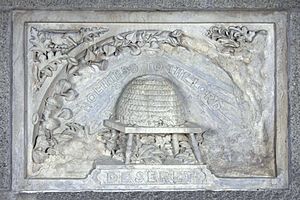
Inside the monument, there are 194 special memorial stones. These stones were donated by different states, cities, countries, and organizations. They are placed in the interior walls, mostly on the east and west sides, so visitors can see them easily.
The stones are made of various materials like marble, granite, limestone, and sandstone. Some unusual materials include native copper from Michigan and petrified wood from Arizona. They come in different sizes.
One stone from Utah has an inscription in Welsh: "My Language, My Country, My Nation, Welsh forever." Another stone was donated by the Ottoman Sultan Abdul Mejid I, who gave $30,000 for the monument. His stone, on the 190-foot level, says, "To support the continuation of true friendship Abdul Mejid Khan's clear and pure name was written on the lofty stone in Washington."
Some stones have unique messages. For example, one from the Templars of Honor and Temperance stated, "We will not make, buy, sell, or use as a beverage, any spiritous or malt liquors, Wine, Cider, or any other Alcoholic Liquor."
The Aluminum Top
The very top of the monument is a small pyramid made of aluminum. This aluminum top was cast by William Frishmuth in Philadelphia. When it was made, it was the largest piece of aluminum in the world. Before it was installed, it was displayed in New York City, and people could step over it!
The aluminum top is about 8.9 inches (23 cm) tall. It originally served as a single lightning rod. Its four sides have inscriptions written in cursive. Most of these are the original 1884 inscriptions. One important inscription on the east face says "Laus Deo," which is Latin for "Praise be to God."
Lightning Protection
The pointed top of the monument, the pyramidion, was designed with the aluminum apex as a lightning rod. After lightning damaged the marble in 1885, a network of gold-plated copper rods with platinum-tipped points was installed over the entire pyramidion. This system protects the monument from lightning strikes.
The Walls
The walls of the monument were built in two main phases. The first phase (1848–1854) used rough bluestone gneiss rubble and marble for the outer surface. The outer marble stones were about 14 to 18 inches (36–46 cm) thick.
The second phase (1879–1884) used smoothly cut large marble and granite blocks. These stones were laid in a very organized way. The marble for the first phase came from a quarry in Maryland. The marble for the second phase came from different quarries in Massachusetts and Maryland.
The Pyramidion (Top Section)
The marble capstone at the very top of the pyramidion is a pyramid shape with a special keystone that holds it in place. The aluminum apex sits on top of this capstone.
The pyramidion itself is built in a very clever way to be strong but not too heavy. Its outer slabs are usually only 7 inches (18 cm) thick. Inside, there are marble ribs that transfer the weight to the main walls of the shaft. The pyramidion is 55 feet 0 inches (16.76 m) high.
The observation floor, where visitors can look out, is about 499 feet (152.10 m) above the entrance. There are eight observation windows, two on each side, which are now covered with strong, shatterproof glass.
The Foundation
The first part of building the monument involved digging down about 7 feet (2.1 m) to find solid ground. The cornerstone was laid there, and then the rest of the original foundation was built using bluestone gneiss rubble and mortar. This old foundation was about 23 feet (7.0 m) high and 80 feet (24.4 m) square at its base.
During the second phase of construction, engineers realized the original foundation wasn't strong enough for the monument's full weight. So, they strengthened it by adding a large concrete slab underneath the old foundation. This made the base much wider and stronger. The entire reinforced foundation is now about 36 feet (11.0 m) deep. An earthen hill, called a knoll, was also built around the base. This helps support the foundation even more.
Stairs and Elevator
The inside of the monument has iron stairs that spiral up the walls and an elevator in the center. The stairs and elevator are supported by iron columns, but these columns do not hold up the stone walls of the monument.
The main stairs go from the lobby up to the 490-foot level. The elevator takes visitors from the lobby to the observation floor. The stairs used to be open for visitors to climb, but they were closed to the public in 1976.
The original steam-powered elevator took 10 to 12 minutes to reach the top. It was replaced by an electric elevator in 1901, which took five minutes. Today's modern electric elevators can reach the top in about 70 seconds. During recent renovations, glass panels were added at some platforms so visitors on the elevator can see the memorial stones as they go down.
Flags Around the Monument
Today, fifty American flags, one for each state, fly 24 hours a day in a large circle around the monument. This tradition started in 1958, when 48 flags were flown daily. The number increased as Alaska and Hawaii became states. Since July 4, 1971, all 50 flags have flown continuously.
Security Measures
After the September 11 attacks in 2001, a temporary security screening center was added at the monument's entrance. Visitors pass through metal detectors and other sensors before entering. This facility was built to keep visitors safe.
In 2014, a new, permanent visitor screening facility was approved. It is designed to blend in with the monument's surroundings and will have bulletproof glass walls. It also includes offices for park staff.
A special low wall, called a ha-ha wall, was built around the monument. This wall acts as a security barrier to prevent vehicles from getting too close, but it is designed to be subtle and not block the view of the monument. It also has lighting and can be used as a seating bench.
How to Get There
The Washington Monument is served by the Smithsonian metro station.
See also
 In Spanish: Monumento a Washington para niños
In Spanish: Monumento a Washington para niños


